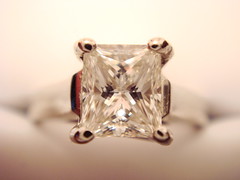 Note: Honesty compels me to reveal that I received a review copy of the following title from the author.
Note: Honesty compels me to reveal that I received a review copy of the following title from the author.If most men ever to become experts in gemstones, it's usually at a very specific point in life -- about six weeks before proposing. Caught up in the preparatory whirlwind of asking for a woman's hand in marriage, they go from knowing about as much as the toddler who can recite "Twinkle, Twinkle, Little Star" to parsing technical terms such as "culet" and "VS2" and "carat weight" with ease. All that education tends to fall away pretty quickly after popping the question (and even faster if the answer isn't in the affirmative). But if there's a novel to call back to mind that hard-won info, it's Stephen Parrish's The Tavernier Stones, a historical adventure stuffed with carbuncles aplenty.
Petrified corpses turned up in the bogs outside of Hamburg with enough regularity to make them, at most, of only minor interest. Long-embalmed by peaty acids, bodies sometimes as old as the Iron Age heave up from the marshy ground, their blackened skins so well preserved that you can read the expressions on their faces. So it wasn't odd when two boys stumbled upon a mummified cadaver while camping -- or wouldn't have been if the dead man's hand hadn't clutched a 57-carat ruby. No ordinary stiff, this was seventeenth-century cartographer Johannes Cellarius, a mapmaker who died with eleven blows from a pickax in his chest and who may have been entangled with the legendary Tavernier gems. That collection of jewels would reputedly make the Hope Diamond look unimpressive. You can bet that the media finds a mythic cache of gems far more interesting than a mere body in a bog. One of the world's biggest treasure hunts is about to begin ...
The Tavernier Stones possesses something of unique structure. An ensemble story, it reveals pertinent clues to the search while jumping back and forth between a bevy of characters. And what a collection it is. An ostracized Amish cartographer. A brilliant grifter and his lingerie-model girlfriend. A merciless heiress and the deviant thug who does her dirty work. A corrupt cop trying to decide whether or not to kill his cheating wife. Indeed, at points Parrish flirts with hardboiled, dropping dark hints in a line of dialogue here, a snatch of description there. Such revelations of his characters' amorality are quite well done. The only point where The Tavernier Stones stumbles is at a tendency to fall into lengthy historical explications. True, a book relying on the past to fuel present action needs a few. But the plot often screeches to a halt while detailing, say, the finer points of the reign of Louis XIV or the vinting practices of a coven of German witches. Such expository lumps may be flaws, but as an entertaining read Stones shines pretty bright all the same.
(Picture: CC 2007 by stephend9)


4 comments:
Well-reviewed, Loren. I love this book (obviously).
Six weeks before proposing, eh? So with what did you propose to Mrs. Loren?
Some pretty successful authors get away with similar plot screeching pretty regularly, if I remember rightly. Louis L'amour and Micheal Crichton spring to mind.
Aerin,
I popped the question to my dear wife with a rock, a restaurant I couldn't really afford and a proposal she (bless her) thought was sweet but probably a little bit sentimental and silly. She stuck with me, for which I'm eternally thankful.
Sam,
I haven't read L'amour, but Tavernier reads quite differently from Crichton. There's a lot more history and interest in ciphers. Also, perspective really is quite unique.
Post a Comment